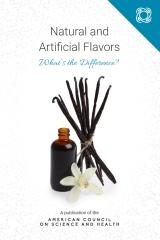
The American Council on Science and Health, since 1978 America's premiere pro-science consumer advocacy non-profit, is pleased to announce our new book, "Natural and Artificial Flavors: What's the Difference?", in order to combat growing confusion about health issues related to food.
During the last decade, it has become increasingly fashionable to tout "natural" on product labels. It isn't just fringe companies that prey on the chemophobia evident among less-informed members of the public, larger brands have also been exploiting consumers in this fashion.
Yet the distinction between artificial and natural flavors is entirely manufactured. Aside from subjective taste differences, the only way to know the difference is the lack of additional chemicals natural flavors have.
"The Council has always been about separating health scares from health threats, and the natural color and flavor craze is very much a health scare," says Dr. Josh Bloom, Senior Director of Chemical and Pharmaceutical Sciences at the American Council on Science and Health and author of the peer-reviewed book. "There may be some differences in taste between a natural and artificial flavor, but that's because an artificial flavor is precise; a grape from a plant, for example, has a lot of variation in taste due to lots and lots of chemicals that make up its total flavor."
The American Council on Science and Health appreciates the contributions of the reviewers named below:
Rhona Applebaum, Ph.D., Executive (retired) Food Association, New York, NY
Martin Di Grandi, Ph.D., Associate Professor of Chemistry, Fordham College at Lincoln Center
Joe Schwarcz, Ph.D., Professor of Chemistry, McGill University, Montreal
Michael D. Shaw, Ph.D., Executive Vice President, Interscan Corporation, Reston, VA
Christoph W. Zapf, Associate Director, Medicinal Chemistry, Nurix, Inc., San Francisco, CA
The American Council on Science and Health (ACSH) is a 501(c)(3) science and health education and consumer advocacy nonprofit that was founded in 1978 to promote evidence-based science and health policy. Like all Council publications, this is open access and available free of charge to all consumers. It can be read or downloaded in the link at the bottom.
If you would like to support evidence-based decision-making, you can make a tax-deductible donation here:
If you want to subscribe to our work free of charge, you can do so here.
For consumers who want a printed copy for their collection, the book can also be purchased on Amazon:
US
Natural and Artificial Flavors: What's the Difference?
International:
http://www.amazon.co.uk/dp/0991005597
http://www.amazon.de/dp/0991005597
http://www.amazon.es/dp/0991005597
http://www.amazon.fr/dp/0991005597
http://www.amazon.it/dp/0991005597
You can download Natural and Artificial Flavors: What's the Difference? free of charge or read it in the window below at the American Council on Science and Health on Scribd



